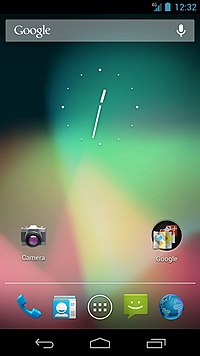Android (operating system)
From Wikipedia, the free encyclopedia
 |
|
|---|---|
 Home screen displayed by Samsung Galaxy Nexus, running Android 4.1 "Jelly Bean" |
|
| Company / developer | Google, Open Handset Alliance, Android Open Source Project |
| Programmed in | C, C++, Java[1] |
| OS family | Unix-like, Linux |
| Working state | Current |
| Source model | Open source[2] |
| Initial release | September 23, 2008[3] |
| Latest stable release | 4.1 Jelly Bean[4] / July 10, 2012[5] |
| Marketing target | Smartphones and Tablet computers |
| Available language(s) | Multi-lingual |
| Package manager | Google Play / APK |
| Supported platforms | ARM, MIPS,[6] x86[7] |
| Kernel type | Monolithic (modified Linux kernel) |
| Default user interface | Graphical (Multi-touch) |
| License | Apache License 2.0 Linux kernel patches under GNU GPL v2[8] |
| Official website | www.android.com |
Google releases the Android code as open-source, under the Apache License.[11] The Android Open Source Project (AOSP), lead by Google, is tasked with the maintenance and further development of Android.[12] Additionally, Android has a large community of developers writing applications ("apps") that extend the functionality of devices. Developers write primarily in a customized version of Java,[13] and apps can be downloaded from online stores such as Google Play (formerly Android Market), the app store run by Google, or third-party sites. In June 2012, there were more than 600,000 apps available for Android, and the estimated number of applications downloaded from Google Play was 20 billion.[14]
The first Android-powered phone was sold in October 2008,[15] and by the end of 2010 Android had become the world's leading smartphone platform.[16] It had a worldwide smartphone market share of 59% at the beginning of 2012,[17] and as of third quarter 2012, there were 500 million devices activated and 1.3 million activations per day.[18][19]



0 komentar:
Posting Komentar